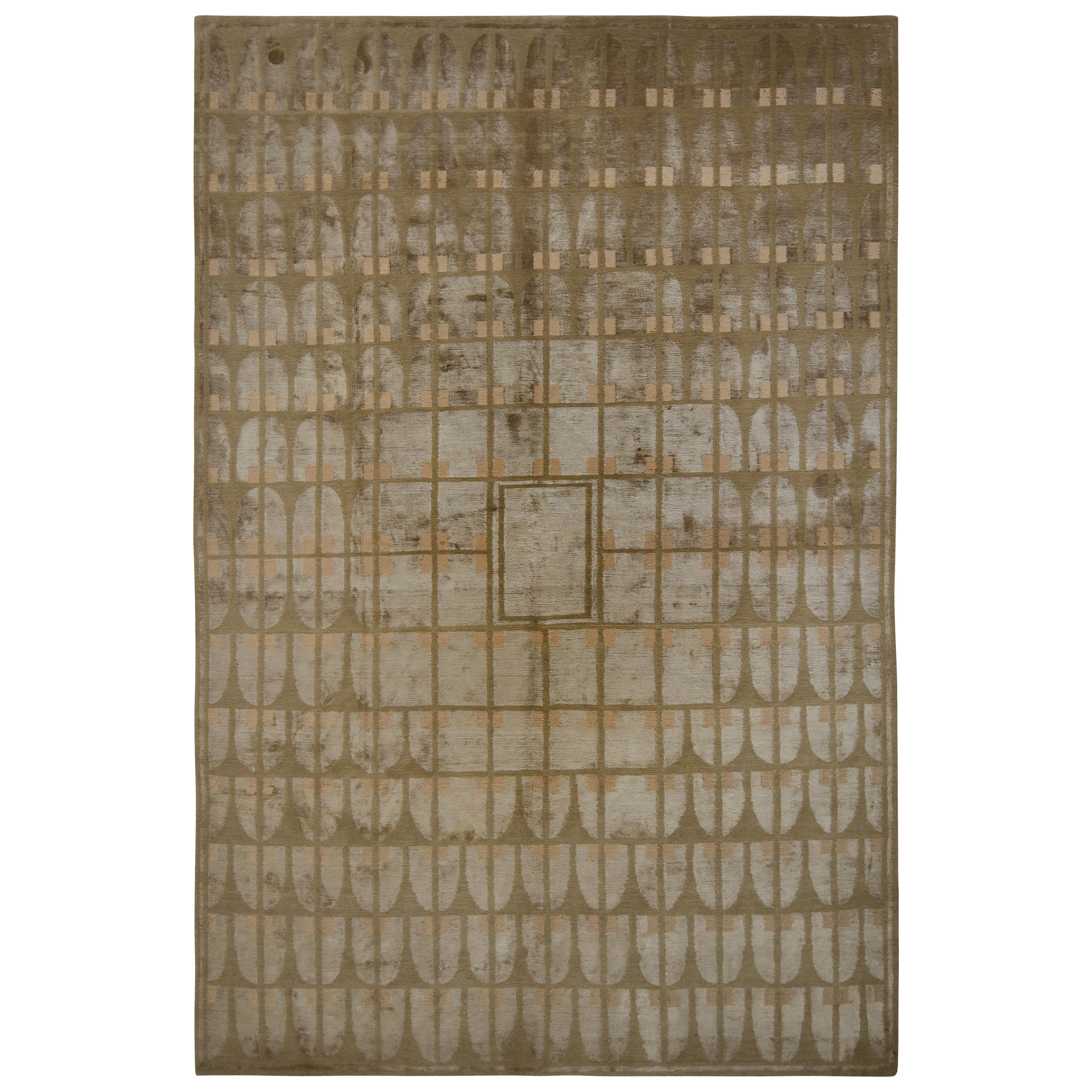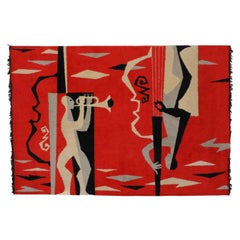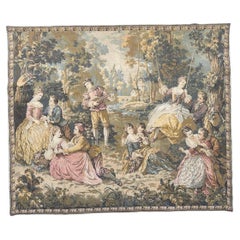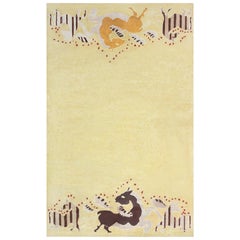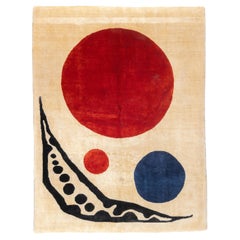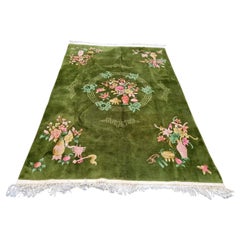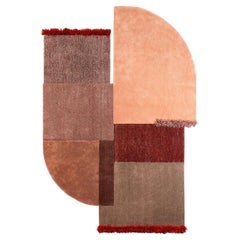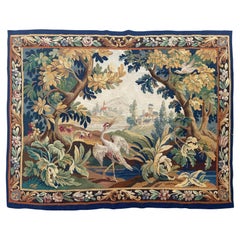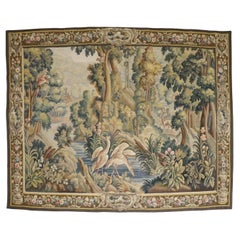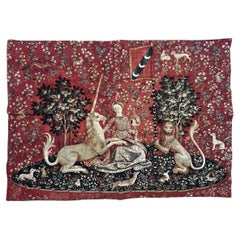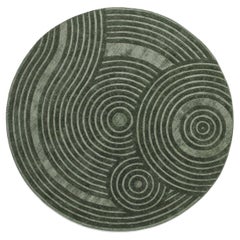Western European Rugs
to
1,643
Width
to
Length
to
4,072
3,810
102
2,295
496
432
153
120
40
34
34
30
22
11
11
9
9
8
7
7
3
411
674
2,725
4,174
728
1,314
544
89
48
145
96
75
133
175
156
72
103
7,432
6,445
1,293
970
199
3,629
3,628
7,984
5,146
5,982
4,844
2,897
2,149
1,761
1,362
574
308
122
103
75
Western European Rugs For Sale
Handmade Vintage Art Deco Chinese Rug 5.5' x 8.2' 1960s - 2K25
Located in Bordeaux, FR
A Glimpse into Art Deco Elegance
This charming vintage Art Deco Chinese rug, dating from the 1960s, offers a unique blend of traditional artistry and mid-century design. Handmade wit...
Category
1960s French Vintage Western European Rugs
Materials
Wool
Selce #4 Emathite Red Rug by Studio Salaris by Carpet Edition
Located in Milan, IT
A stunning combination of earth tones graces the surface of this asymmetrical rug designed by Studio Solaris and part of the Selce Collection. Contemporary and unconventional, this p...
Category
2010s Italian Western European Rugs
Materials
Textile
Pretty antique french Aubusson tapestry “greenery and birds”
Located in Saint Ouen, FR
Very beautiful antique French Aubusson tapestry featuring a view of the nature in the woods, with birds, trees and a river. we can see further away, village houses. With nice natural...
Category
Mid-20th Century French Aubusson Western European Rugs
Materials
Wool, Silk
$3,642 Sale Price
20% Off
Zabihi Collection 19th Century French Aubusson Tapestry
Located in New York, NY
a 19th Century Hand Loomed French Aubusson Tapestry
Details
rug no. j4421
size 4' x 5' 6" (122 x 168 cm
Category
Mid-19th Century Asian Vienna Secession Antique Western European Rugs
Materials
Wool
Pretty vintage Aubusson style Jacquard tapestry medieval design “the view”
Located in Saint Ouen, FR
Discover the elegance of "La Dame à la Licorne" titled “The view”– a beautiful late 20th-century tapestry echoing the 15th-century masterpiece at the Cluny Museum in Paris. Woven wi...
Category
Late 20th Century French Aubusson Western European Rugs
Materials
Wool, Cotton, Acrylic
$1,207 Sale Price
20% Off
Zen Muschio Round Rug by Sitap Carpet Couture Italia
Located in Milan, IT
The Zen moss-green rug embodies the tranquility of a Japanese garden through its two-level weaving technique. Perfect for living spaces, bedrooms, and contract areas, it is the brain...
Category
2010s Italian Western European Rugs
Materials
Textile
Vanità Flower Polychrome Poly-Blend Rug by Ken Scott
Located in Milan, IT
Textural and chromatic dynamism maximize the decorative impact of this superb flower-shaped artisan rug. Part of an original Collection where art, fashion, and design seamlessly inte...
Category
2010s Italian Western European Rugs
Materials
Wool
cc-tapis CORNERS handmade rug by Eny Lee Parker
Located in Brooklyn, NY
Eny Lee Parker, a spatial designer based in New York, draws inspiration from her work with clay. She physically sculpts with clay, then scans the textures and irregular edges to crea...
Category
21st Century and Contemporary Nepalese Western European Rugs
Materials
Wool
$9,945 / item
Contemporary Hand-Knotted Wool Rug with Organic Modern Pattern
By Nasiri
Located in New York, NY
Elevate your space with this striking contemporary hand-knotted wool rug, featuring a bold and organic pattern inspired by modern abstract art. Rendered in a lively palette of coral,...
Category
2010s European Organic Modern Western European Rugs
Materials
Wool
Moon Sand Rug by Sitap Carpet Couture Italia
Located in Milan, IT
An elegant handloom viscose luxury rug, this piece features a subtle half-moon silhouette inspired by lunar phases, achieved by shaving a line on the fleece. The almost-white viscose...
Category
2010s Italian Western European Rugs
Materials
Textile
Handmade Antique Persian Gashkai Rug 4.7' x 9.9' (142 x 302 cm), 1900s - 2K03
Located in Bordeaux, FR
This antique Persian Qashqai rug, dating back to the 1900s, embodies the rich tribal weaving traditions of the Qashqai nomads. Crafted from high-quality wool, this rug features bold ...
Category
Early 1900s German Antique Western European Rugs
Materials
Wool
Nice vintage French Aubusson Style Jacquard Tapestry cushion face
Located in Saint Ouen, FR
"Pretty small French tapestry from the late-20th century, featuring a beautiful design and nice colours, woven in jacquard loom by wool acrylic a...
Category
Late 20th Century French Aubusson Western European Rugs
Materials
Wool, Cotton, Acrylic
$172 Sale Price
20% Off
cc-tapis COMPOSITION 4 Rectangular handmade rug by Kwangho Lee
By Kwangho Lee, cc-tapis
Located in Brooklyn, NY
Inspired by his copper series, Kwangho Lee and cc-tapis present The Color of Copper (TCOC), a collection of four hand-knotted rugs that reinterpret the oxidation process of this meta...
Category
21st Century and Contemporary Nepalese Western European Rugs
Materials
Wool, Silk
Nice vintage French Aubusson Style Jacquard Tapestry cushion face
Located in Saint Ouen, FR
"Pretty small French tapestry from the late-20th century, featuring a beautiful design and nice colours, woven in jacquard loom by wool acrylic a...
Category
Late 20th Century French Aubusson Western European Rugs
Materials
Wool, Cotton, Acrylic
$172 Sale Price
20% Off
cc-tapis TWINS LIGHT handmade rug by Eny Lee Parker
Located in Brooklyn, NY
Eny Lee Parker, a spatial designer based in New York, draws inspiration from her work with clay. She physically sculpts with clay, then scans the textures and irregular edges to crea...
Category
21st Century and Contemporary Nepalese Western European Rugs
Materials
Wool
$9,605 / item
pretty antique French medieval design Aubusson style Jacquard tapestry
Located in Saint Ouen, FR
"Experience the timeless elegance of 'Scènes Galantes,' a stunning early 20th century French tapestry featuring a medieval design inspired by the 15th-century masterpiece from the Cl...
Category
Mid-20th Century French Aubusson Western European Rugs
Materials
Wool
$1,897 Sale Price
20% Off
Pretty Vintage Aubusson Style Jacquard Tapestry
Located in Saint Ouen, FR
Beautiful vintage French Aubusson style tapestry with a nice design of the women and men of the town inside the wood, and with a river. and with beautiful colours, entirely woven wit...
Category
Mid-20th Century French Aubusson Western European Rugs
Materials
Wool, Cotton
$1,725 Sale Price
20% Off
Pretty Vintage Aubusson Style Jacquard Tapestry
Located in Saint Ouen, FR
Beautiful vintage French Aubusson style tapestry with a nice design of the horses ,and with beautiful colours, entirely woven with wool And cotton on Jacquard looms
✨✨✨
"Experience ...
Category
Mid-20th Century French Aubusson Western European Rugs
Materials
Wool, Cotton
$939 Sale Price
20% Off
cc-tapis CORNERS handmade rug by Eny Lee Parker
Located in Brooklyn, NY
Eny Lee Parker, a spatial designer based in New York, draws inspiration from her work with clay. She physically sculpts with clay, then scans the textures and irregular edges to crea...
Category
21st Century and Contemporary Indian Western European Rugs
Materials
Wool
$10,530 / item
Oversized Antique Aubusson Rug, Floral Medallion in Cream and Pink - Rug & Kilim
Located in Long Island City, NY
This 14x17 antique Aubusson rug in the and is a rare oversized curation from Rug & Kilim’s European rug collection—a gorgeous palace rug recapturing the Neoclassical style, handwoven...
Category
1890s French Bessarabian Antique Western European Rugs
Materials
Wool
$48,000 Sale Price
20% Off
Antique Signed French Jean-Baptiste Deshays Pictorial Tapestry - Rug & Kilim
Located in Long Island City, NY
Made with handwoven wool, this 12x18 antique French Beauvais tapestry represents an iconic museum-quality addition to Rug & Kilim's Tapestry Collection—an extremely collectible and r...
Category
1720s French Aubusson Antique Western European Rugs
Materials
Wool
$200,000 Sale Price
20% Off
Handmade Vintage Persian Luri Rug 3.4' x 5' 1960s - 2K26
Located in Bordeaux, FR
A Glimpse into Nomadic Heritage
This authentic vintage Persian Luri rug, crafted in the 1960s, is a captivating example of tribal weaving art. Handmade by nomadic artisans, this wool...
Category
1960s French Vintage Western European Rugs
Materials
Wool
Wonderful extremely fine antique silk french Beauvais tapestry «Flower Harvest»
Located in Saint Ouen, FR
Very beautiful late 19th century French Aubusson tapestry of Beauvais with a nice design of flower Harvest, Beautiful women are gathering flowers in the garden and the woods, chatti...
Category
Late 19th Century French Aubusson Antique Western European Rugs
Materials
Silk
Modern French needlepoint tapestry Attribute to Hervé Lelong
By Hervé Lelong
Located in Saint Ouen, FR
Beautiful tapestry from 20th century with a modern design with the name of artist Hervé Lelong, entirely hand embroidered with needlepoint method by wool on cotton foundation
Category
Mid-20th Century French Art Deco Western European Rugs
Materials
Wool
$1,341 Sale Price
20% Off
pretty Antique French Aubusson style Jacquard tapestry, chair or cushion cover
Located in Saint Ouen, FR
"Experience the timeless elegance of this exquisite fragment of an French Aubusson style tapestry, capturing the essence of a natural design , Woven on a Jacquard loom with wool. Ori...
Category
Early 20th Century French Aubusson Western European Rugs
Materials
Wool
$143 Sale Price
20% Off
Oversized Antique Axminster Rug in Red with Bokhara Medallions - Rug & Kilim
Located in Long Island City, NY
Hand-knotted in wool, this 16x23 Antique rug is a rare oversized curation believed to be of Bokhara provenance from Rug & Kilim’s coveted Antique collection.
On the Design:
A ri...
Category
1910s English Vintage Western European Rugs
Materials
Wool
$54,400 Sale Price
20% Off
Selce #1 Rug by Studio Salaris
Located in Milan, IT
Warm greens, mustard yellow, and gray hues mix with bright yellow and red in this exquisite rug that combines an asymmetrical silhouette and a variety o...
Category
2010s Italian Western European Rugs
Materials
Textile
$10,804 / item
Pretty Vintage French Aubusson Style Jacquard Tapestry, Verdure
Located in Saint Ouen, FR
Beautiful vintage French Aubusson style tapestry with a nice design of Typical 18th century verdure, depicting a green country landscape with a pond.
Bring a little reminder of natu...
Category
Mid-20th Century French Aubusson Western European Rugs
Materials
Wool
$2,166 Sale Price
20% Off
Pretty antique french Aubusson tapestry
Located in Saint Ouen, FR
Very beautiful antique French Aubusson tapestry featuring a view of a woman showing a bird in the nature in the woods. With nice natural colours in the hues of yellow, green, pink, o...
Category
Late 19th Century French Aubusson Antique Western European Rugs
Materials
Wool, Silk
$1,725 Sale Price
20% Off
Bobyrug’s Nice French Aubusson Style Jacquard Tapestry “Berger Galant”
Located in Saint Ouen, FR
"Exquisite French tapestry from the mid-20th century, featuring a design reminiscent of François Boucher's paintings. Titled 'Le Berger Galant,' this captivating piece portrays a cha...
Category
Mid-20th Century French Aubusson Western European Rugs
Materials
Wool, Cotton
$2,770 Sale Price
29% Off
Murano Swirl Round Black Rug
Located in Milan, IT
Actualization of the invisible lines a whirlwind traces, the raised design characterizing this rug allows to appreciate it with both eye and touch. A combination of wool and cotton w...
Category
2010s Italian Modern Western European Rugs
Materials
Textile
$1,127 / item
Wonderful Vintage French Aubusson style Hand Printed Tapestry “ reading”
Located in Saint Ouen, FR
Very beautiful mid century French Aubusson style tapestry with a design of an medieval museum design tapestry titled «La Lecture »
Showing A young man reads verses to the lady he is ...
Category
Mid-20th Century French Aubusson Western European Rugs
Materials
Wool, Cotton
$747 Sale Price
20% Off
Rug & Kilim's Hand Knotted European Style Rug Beige-Brown Green Floral Pattern
By Rug & Kilim
Located in Long Island City, NY
Hand knotted in one of the most respected looms in Nepal, this 4 x 6 rug joins the European collection by Rug & Kilim, this design affectionately entitled “Arabesque” named for the i...
Category
2010s Nepalese Art Deco Western European Rugs
Materials
Wool, Silk
$1,960 Sale Price
20% Off
Pretty Vintage Aubusson Style Jaquar Tapestry
Located in Saint Ouen, FR
Very pretty Aubusson style tapestry with nice galant design and beautiful colors, woven with mechanical Jaquar looms with wool, acrylic and cotton.
✨✨✨
"Experience the epitome of lu...
Category
21st Century and Contemporary Chinese Aubusson Western European Rugs
Materials
Wool, Cotton, Acrylic
$335 Sale Price
20% Off
Antique Signed French Jean Picart le Doux Green Pictorial Tapestry - Rug & Kilim
Located in Long Island City, NY
Made with hand-knotted wool circa 1950-1960, this 4x5 antique French tapestry represents a distinguished addition to Rug & Kilim's Tapestry collection—an exceptional example of mid-c...
Category
1950s French Vintage Western European Rugs
Materials
Wool
$11,200 Sale Price
20% Off
Zabihi Collection Dramatic Mid 19th Century English Needlepoint
Located in New York, NY
Dramatic mid 19th Century English Needlepoint ~
7'7'' x 16'3''
English needlepoint rugs, renowned for their profuse floral motifs, reached an artistic zenith in 1700-1750 but were...
Category
Mid-19th Century English Aubusson Antique Western European Rugs
Materials
Wool, Cotton, Foam
Zebra-Striped Printed Leather Rug Black & White
Located in Milan, IT
The Zebra-Striped Printed Leather Black & White Rug takes inspiration from the appeal of the animalier style. A timeless pattern full of character will make this accessory the hero i...
Category
2010s Italian Western European Rugs
Materials
Leather
$2,237 / item
Irregular Shape Hand-Tufted Wool Rug 'San Junipero' by Rannisa Soraya RAG Home
Located in Jakarta Selatan, ID
Irregular Shape Hand-Tufted Wool Rug 'San Junipero' by Rannisa Soraya RAG Home
Mixed Shapes and Colors in Terracotta Green Orange
Hand-tufted viscose wool with mixed methods carving embossed, cut...
Category
2010s Indonesian Art Deco Western European Rugs
Materials
Wool
$1,840 Sale Price / item
20% Off
Modern Handwoven Polypropylene Outdoor Rug Carpet Light Green&Turquoise Gelato
By Kilombo Home
Located in Madrid, ES
This rug has been ethically hand woven in polypropylene yarns by artisans in north of India, using a traditional weaving technique which is native of this region.
It´s resistant to ...
Category
21st Century and Contemporary Indian Modern Western European Rugs
Materials
Acrylic
1980 Vintage Oriental Kilim Rug
Located in Los Angeles, US
Antique Bessarabian Rugs / Kilims in both pile and tapestry weaving technique are some of the more beautiful carpets to have been produced in Europe. Many of the Bessarabian Kilims w...
Category
1980s Russian Bessarabian Vintage Western European Rugs
Materials
Wool, Cotton
Marilyn Limited Edition Rug Design by Studio Amebe
Located in Milan, IT
A captivating tribute to Marilyn Monroe's famous scene from The Seven Year Itch where her dress rises up with the wind from the subway grate below, this stunning limited edition rug ...
Category
2010s Italian Western European Rugs
Materials
Textile
Bobyrug’s Beautiful Antique French Aubusson Tapestry
Located in Saint Ouen, FR
Wonderful mid century French Aubusson tapestry with beautiful design of nature with birds and beautiful natural colors, entirely hand woven ...
Category
Early 20th Century French Aubusson Western European Rugs
Materials
Wool
$3,412 Sale Price
20% Off
Sasha Bikoff X Art Hide Faux Bois Customizable Cowhide Dans Le Bois Area Rug
By Art Hide
Located in Charlotte, NC
Dans Le Bois is more than just a rug, it's a statement. With its abstract and almost graphic-like subject matter, it truly captures the essence of the 70s. But what sets it apart is ...
Category
2010s Pakistani Art Deco Western European Rugs
Materials
Cowhide
$6,791 Sale Price
15% Off
Oversized Antique French Savonnerie Rug with Floral Patterns
Located in Long Island City, NY
This 19x19 antique Aubusson rug is an exciting new addition to Rug & Kilim’s European rug collection—a masterpiece of the French Neoclassical flatweave style, handwoven in wool and o...
Category
1790s French Kilim Antique Western European Rugs
Materials
Wool
$144,000 Sale Price
20% Off
Pretty antique Century French Aubusson style Jacquard Tapestry
Located in Saint Ouen, FR
Very pretty antique french Aubusson style tapestry with beautiful design from the nature with an eagle. Woven on Jacquard loom with wool and cotton.
✨✨✨
"Experience the epitome of lu...
Category
Early 20th Century French Aubusson Western European Rugs
Materials
Wool, Cotton
Modern Style Irregular Shape Carpet 'Dancing Dimension' by RAG
By RAG home
Located in Jakarta Selatan, ID
Modern style Irregular shape carpet 'Dancing Dimension' by RAG
Original Designed by Rannisa Soraya RAG Home Jakarta
Hand-tufted with mixed Carving Em...
Category
2010s Indonesian Modern Western European Rugs
Materials
Wool
Pretty Vintage Aubusson Style médiéval design Jacquard Tapestry
Located in Saint Ouen, FR
very beautiful French Aubusson style tapestry, with a design of a medieval tapestries. This tapestry has been made in the renowned “La Filandière” manufacturing
Beautiful colours w...
Category
Mid-20th Century French Medieval Western European Rugs
Materials
Wool, Cotton
$2,396 Sale Price
20% Off
Rare Antique French Tapestry "Entre Fenetres", circa 1880
Located in New York, NY
Rare Antique French
Aubusson Tapestry
"Entre Fenetres"
Wool & Silk
Gold 4'3" x 6'5"
(122cm x 196cm)
circa 1880
"This is an Rare Antique French Wool & Si...
Category
1880s French Baroque Antique Western European Rugs
Materials
Wool
$4,231 Sale Price
20% Off
Nice Antique French Hand Printed Lurçat Signed Tapestry « Rooster »
Located in Saint Ouen, FR
Very beautiful antique french hand printed tapestry by renowned Cotto manufacturer with nice design of Jean Lurçat, titled « Coq » (Rooster) with a signature printed on the design of...
Category
Mid-20th Century French Art Deco Western European Rugs
Materials
Cotton
$2,770 Sale Price
20% Off
Antique Bessarabian Kilim in Light Green with Floral Patterns Rug & Kilim
Located in Long Island City, NY
Handwoven in a wool flatweave and originating from Ukraine circa 1900, this 14x19 antique Bessarbian kilim with floral patterns is one of the most special and exciting new pieces to ...
Category
Early 1900s Ukrainian Kilim Antique Western European Rugs
Materials
Wool
$100,000 Sale Price
20% Off
Homage to the Square Rug ‘Blue or Pink or Red’ by Josef Albers
By Josef Albers
Located in Jersey City, NJ
This beautiful, hand-tufted, 100% wool rug is adapted from the 1951 oil on masonite painting by Josef Albers. The rug is available in a limited edition of 150 and produced in associa...
Category
2010s Indian Western European Rugs
Materials
Wool
Irregular Shape with Contemporary Style with Shades of Terracotta Pink by RAG
By RAG home
Located in Jakarta Selatan, ID
This rug is a playground of abstract geometric and organic shapes, stacked into a playful and ludic composition.
Acrylic Wool with Certification from Indonesian Government provi...
Category
2010s Indonesian Modern Western European Rugs
Materials
Wool, Acrylic
Pretty antique Hungarian embroidery tissue
Located in Saint Ouen, FR
Beautiful antique hungarian embroidered tissue fragment , with beautiful designs of flowers and with nice natural colours, entirely hand embroide...
Category
Early 19th Century Hungarian Aubusson Antique Western European Rugs
Materials
Silk
Beautiful Vintage French Jaquar Tapestry basket of flowers design
Located in Saint Ouen, FR
Exquisite vintage French Aubusson style tapestry, with beautiful design of a basket of flowers and beautiful colours with a red background, pink, orange, yellow, blue green and white...
Category
Late 20th Century French Aubusson Western European Rugs
Materials
Wool, Cotton
$853 Sale Price
20% Off
cc-tapis Orizzonti Selva Rug by Eligo Studio
By cc-tapis
Located in Brooklyn, NY
Handwoven in the cc-tapis atelier in Kathmandu, Nepal. The rug is made with a cotton weave, Himalayan wool and bamboo silk pile coming from the areas surrounding the atelier. The sal...
Category
21st Century and Contemporary Nepalese Modern Western European Rugs
Materials
Cotton, Wool, Silk
cc-tapis Double Slinkie Rug by Patricia Urquiola
Located in Brooklyn, NY
Hand knotted in the cc-tapis atelier in Kathmandu, Nepal. The rug is made with a cotton weave and Himalayan wool coming from the areas surrounding the atelier. 152.000 individual kno...
Category
21st Century and Contemporary Nepalese Modern Western European Rugs
Materials
Cotton
$12,124 / item
Handmade Vintage Caucasian Kazak Rug 3' x 4.3' 1970s - 2K36
Located in Bordeaux, FR
A Bold Statement of Caucasian Artistry
This handmade vintage Caucasian Kazak rug, dating from the 1970s, is a striking example of robust tribal artistry. Kazak rugs are highly prized...
Category
1970s French Vintage Western European Rugs
Materials
Wool
' Pink Opaque ' Abstract Irregular Round Shape Hand-Tufted Rug by RAG Home
By RAG home
Located in Jakarta Selatan, ID
' Pink Opaque ' contemporary irregular round shape hand-tufted Viscose wool rug by RAG Home
Original Designed by Rannisa Soraya from RAG Home
Hand-tufted ...
Category
2010s Indonesian Modern Western European Rugs
Materials
Wool
Verner Panton 'Luna' Rug 120cm in Dark Green by Verpan
Located in Tilburg, NL
Verner Panton 'Luna' Rug 120cm by Verpan. Current production.
As well as adding a sculptural feature to a room, rugs also serve to emphasize and/or transform the dimensions of the s...
Category
21st Century and Contemporary Danish Mid-Century Modern Western European Rugs
Materials
Wool
Palace Size Antique Senneh Bakhtiari Rug
Located in New York, NY
A magnificent palace size early 20th century Persian Bakhtiari rug from the early 20th century. Large scale all-over design on a dark brown and navy blue ground with lobed diamond sh...
Category
Early 20th Century Persian Black Forest Western European Rugs
Materials
Wool
Recently Viewed
View AllMore Ways To Browse
Bullet Vase
Buncheong Ceramics
Burl Art Deco Cabinet Dry Bar
Camphor Wood Box
Capodimonte Cherub
Carved Wood Deer
Castaing Madeleine
Castelli Platone
Cathedral Clock
Cenedese Aquarium
Ceramic Dogs Italy
Ceramic Elephants 1970s
Chelsea Pottery
Chi Rho
Chinese Han Dynasty Bronze Vase
Chinese Screen Inlay
Chinese Stacking Box
Chinese Wash Stand
